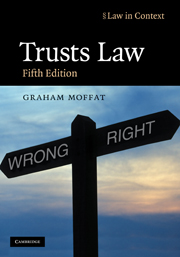Book contents
- Frontmatter
- Contents
- Preface to the fifth edition
- Acknowledgments
- Table of abbreviations
- Useful websites
- Table of statutes
- Table of statutory instruments
- Table of cases
- 1 Trusts introduced
- 2 The evolution of the private express trust
- 3 Taxation, wealth-holding and the private trust
- 4 Creating the trust – I
- 5 Creating the trust – II
- 6 Trusts and public policy
- 7 Flexibility in relation to beneficial entitlement
- 8 The taxation of private trusts
- 9 An introduction to trustees and trusteeship
- 10 Aspects of the management of trusts
- 11 Trusteeship, control and breach of trust
- 12 Implied trusts and the family home
- 13 Trusts in commerce I: occupational pension schemes
- 14 Trusts in commerce II: commerce and equitable remedies
- 15 Trusts in commerce III: commerce, credit and the trust
- 16 Trusts in commerce IV: fiduciary relationships, commerce and the trust
- 17 Trust, contract and unincorporated associations
- 18 An introduction to the law of charity
- 19 A legal definition of ‘charity’
- 20 The regulation of charities
- Index
11 - Trusteeship, control and breach of trust
- Frontmatter
- Contents
- Preface to the fifth edition
- Acknowledgments
- Table of abbreviations
- Useful websites
- Table of statutes
- Table of statutory instruments
- Table of cases
- 1 Trusts introduced
- 2 The evolution of the private express trust
- 3 Taxation, wealth-holding and the private trust
- 4 Creating the trust – I
- 5 Creating the trust – II
- 6 Trusts and public policy
- 7 Flexibility in relation to beneficial entitlement
- 8 The taxation of private trusts
- 9 An introduction to trustees and trusteeship
- 10 Aspects of the management of trusts
- 11 Trusteeship, control and breach of trust
- 12 Implied trusts and the family home
- 13 Trusts in commerce I: occupational pension schemes
- 14 Trusts in commerce II: commerce and equitable remedies
- 15 Trusts in commerce III: commerce, credit and the trust
- 16 Trusts in commerce IV: fiduciary relationships, commerce and the trust
- 17 Trust, contract and unincorporated associations
- 18 An introduction to the law of charity
- 19 A legal definition of ‘charity’
- 20 The regulation of charities
- Index
Summary
Introduction
In the previous two chapters we considered, inter alia, the relationship between trusts law and contemporary trusteeship, including the management of the trust and the powers and duties of trustees associated with that function. One emerging consideration was how far does or should the law seek to intervene to limit the autonomy that settlors might confer on trustees in their management of the trust? In this chapter we focus on the means of controlling trustees, the scope of beneficiaries' rights and the effectiveness of remedies available to them. The appointment and removal of trustees and the control over the exercise of their discretion, issues central to an assessment of trustee autonomy in managing the trust, are considered in sections 2 and 3, whilst the measure of trustee personal liability for breach of trust forms the subject-matter of section 4. Beneficiaries are not restricted to a reliance on the personal liability of trustees as a means of securing recompense for some breach of trust. There may be circumstances where beneficiaries wish to take advantage of the proprietary remedies that the law provides where some breach of trust has occurred. In section 5 we briefly introduce the proprietary remedies that may be available to a beneficiary where the personal remedy against trustees proves inadequate. The full range of the proprietary remedies that equity makes available in cases of breach of trust or where there is some breach of fiduciary duty are considered in detail in Chapter 14.
- Type
- Chapter
- Information
- Trusts LawText and Materials, pp. 532 - 603Publisher: Cambridge University PressPrint publication year: 2009



